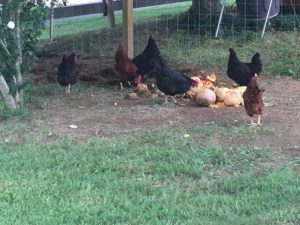A few years ago (before the farm was even thought about), I went out to my composter only to find it was infested with grubs. I was devastated, and could not figure out what in the world had gone wrong. My first thought was my ratio was off – but it couldn’t be: the bin didn’t smell, the consistency was good, I knew that meat and dairy weren’t in there. Thinking my compost was ruined, I put the lid back on, and dejectedly walked back inside to figure out what I was going to do with my mess.
My next step, of course, was to consult The Google. “Grubs in compost bin” was my search argument, and this was the first return: grubs or maggots in my compost bin. Just a few comments down, discussion started of something I’d never heard of before: Black Soldier Flies.
I had no idea that I’d accidentally created a perfect environment for one of the most perfect composters in the entire world. After realizing I really hadn’t created a disaster, I kept adding compost materials and in a few weeks, all my grubs were gone, leaving nothing behind – not even the newly added scraps.
Now, at the farm, the chickens get first crack at the over-ripened vegetables and fruit/vegetable scraps. What they don’t eat then gets transferred to one of the compost tumblers. Because I have several households that save their vegetable scraps for me, I frequently end up with much more compostable material than what the chickens can/should eat. Here you can see them enjoying a delicious breakfast of too-ripe cantaloupe.
Earlier this year, I ran into a huge problem. Both composters were full and cooking, and I knew it didn’t make sense to just keep buying new composter bins just to deal with the excess “green.” Once again, I consulted The Google to see what I could do to speed up the compost process. I found this article: 3 day compost
Black Soldier Flies (BSF) weren’t anything I’d thought about since they visited my compost bin several years earlier. Black Soldier Flies are super speedy composters… but wait! What?! The CHICKENS?? The chickens LOVE them?? My head started spinning at this news, and I’ve not stopped reading and learning about these guys since.
I wanted to do a quick and dirty experiment before spending additional time and money on this project. I decided an open bin at the back of the property would be my best bet to see if I could grow BSF. I let the chickens eat what they wanted from the overripened vegetables, and as soon as they lost interest or mold set in – the vegetables would then be moved to the BSF bin. I read the best way to attract BSF is to leave the rottening fruit and vegetables alone, and the smell would attract them if you live in an indigenous area. The composting girl in me couldn’t believe that I was only putting in pure “green” and expecting compost to happen. The gnats and flies were swarming, it was getting a little stinky, and I couldn’t take looking at all that gross rotten vegetable soup just sitting in the open bin. Although their bin was in full shade, it made me wonder if it was just still too bright for the BSF to thrive. After sprinkling some peat moss over the top to absorb some of the moisture, I grabbed a few of the recycled newspapers I use in the worm bin, and made a giant blanket to cover.
And then we waited.
(to be continued…)
S&B Bell Farms is a participant in the Amazon Services LLC Associates Program, an affiliate advertising program designed to provide a means for sites to earn advertising fees by advertising and linking to www.amazon.com


